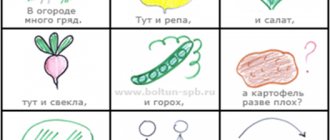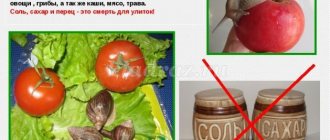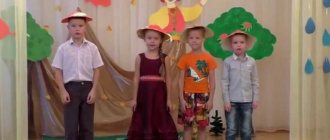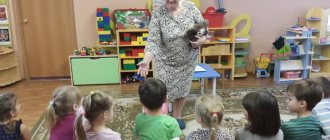GCD for speech development in the middle group according to the Federal State Educational Standard
The main task of a kindergarten teacher is to teach children to answer the questions posed. Initially, an analysis is carried out by the teacher, an appropriate task is selected, and familiarization with the material occurs.
How does speech develop in the middle group according to the Federal State Educational Standard?
ECD for the development of coherent speech in the middle group helps to enrich knowledge about the life of wild animals. When attending kindergarten, already in the fourth year, children should know how animals behave when autumn, winter, spring or summer comes. The purpose of the lesson is, first of all, the formation of cognitive interest in nature, the awakening of a sensory attitude to the beauty of autumn nature.
Note! The teacher fosters a caring attitude and love for the animal and plant world.
Formation of sound culture of speech
A lesson in sound speech is an integral part of general speech culture. Such a software package covers all aspects of the sound design of words or spoken speech:
- correct pronunciation of sounds,
- correct pronunciation of words,
- volume and speed of speech utterance,
- rhythm,
- logical stress,
- normal functioning of the speech-motor apparatus,
- the presence of a complete speech environment.
Particular attention should be paid to the possibility of using music classes in work on the sound culture of speech. This work should be carried out in coordination between the teacher and the music worker, since individual elements of a musical lesson (listening to music, singing, musical-rhythmic movements) develop children’s speech hearing, speech breathing, voice, diction, tempo, rhythm and intonation expressiveness of speech.
Work on intonation expressiveness and emotionality of speech
Planning the development of intonation expressiveness of speech is one of the most important tasks of speech therapy work with preschoolers who have general speech underdevelopment. Normally, children master intonation expressiveness of speech mainly by the age of five. As a rule, this happens naturally in the process of communicating with adults. The family and kindergarten teacher should have a special influence.
Intonation expressiveness and emotionality of speech
Note! Insufficient intonation expressiveness in children of older preschool age with ODD can affect the quality of transmitted information, thereby creating difficulties in mutual understanding and limiting the communicative capabilities of children.
Learning to perceive poetic speech
A developed child can express an interest in fiction from early childhood. With the right approach, every parent can reveal their child's talents at an early stage. Therefore you need to do the following:
- pay attention to expressive means (figurative words, expressions, epithets, comparisons);
- show sensitivity to the poetic word;
- see the main differences between literary genres: fairy tale, story, poem.
Tasks for speech development in the middle group according to the Federal State Educational Standard
Main tasks for the development of speech activity:
- Learn to compose a story based on a picture using a model using dialogic speech;
- Learn to write descriptive stories about vegetables or fruits;
- Exercise in the classification of vegetables and fruits, the formation of diminutive forms of nouns;
- Form ethical standards of behavior: a friendly attitude towards each other in everyday life, during the game;
- Develop attention, thinking, memory, imagination, grammatical structure of speech, tactile sensitivity, intonation side of speech, coherent speech;
- Enrich vocabulary;
- Implement an individually differentiated approach;
- Cultivate respect for people and a friendly attitude in games and in classes.
What tasks do teachers set for speech development in the middle group according to the Federal State Educational Standard?
Summary of a lesson on speech development in the middle group “Description of fruits”
Educational area
Speech development
The topic of the lesson is “Description of fruits.”
Implementation of program content in educational areas :
“Speech development”, “Artistic and aesthetic development”, “Cognitive development”, “Social and communicative development”.
Types of children's activities:
gaming, communicative, educational and research.
Goals:
learn to compare and describe fruits.
Program tasks
:
Educational: continue learning about fruits by solving riddles; learn to describe fruits by color, shape, size; learn to use adjectives in speech, forming them from nouns.
Developing: develop, knows how to maintain a conversation, expresses his point of view, logical thinking, attention.
Educational: To cultivate a caring and loving attitude towards nature, which has generously endowed us with its riches; develop the ability to listen to each other;
Vocabulary work:
fruit, fruity, orange, lemon, cherry, plum, peach,
Preliminary work:
looking at pictures of fruits, the game “What Grows Where”, a conversation on the topic “Fruits”, “Fruit preparations”.
Materials and equipment:
Hedgehog and Little Fox, envelope, pictures of fruits, ball, sheets of paper with images of ovals and circles; two pictures of fruits to find the differences, replicas of fruits, fresh fruits.
Contents of organized children's activities
1. Organizational moment.
Educator: Good afternoon! Happy hour!
I'm very glad to see you.
You turn to each other and smile.
And sit down quietly.
Educator: Guys, who came to us? (Hedgehog and Little Fox are sitting on chairs near the board, holding an envelope)
Children: Hedgehog and little fox
Educator: Yes, these are our friends. Guys, look, they are unusual today, Hedgehog has prepared something for us in an envelope. Let's open it and read it. (Takes the envelope and opens it)
Guys, our friends invite us to play and solve riddles.
Children: stand in a semicircle and look at the board.
2. Guessing riddles. Description of fruits by color and shape.
1.Round, ruddy
It grows on a branch
Adults love him
And little children (apple)
(hang a picture of an apple on the board and the children must talk about it).
Educator: What is this? What color is the apple? What shape? What size is an apple?
Children: The apple is red, round in shape. The apple is big.
2.With orange skin,
Looks like a ball
But the center is not empty,
And juicy and tasty. (Orange)
(There is a picture of an orange on the board).
Educator: What is this? What color is the orange? What shape? What size? Do you think an orange is sweet or sour?
Children: Orange, round in shape...
3.It's almost like an orange
Thick skinned, juicy,
There is only one drawback -
Very, very sour (lemon)
(there is a picture of a lemon on the board).
Educator: What is this? What color is lemon? What shape is it? What size is a lemon?
Children: answer questions
4.Blue uniform, white lining,
It's sweet in the middle. (Plum.)
(on the board there is a picture of a plum).
Educator: What is this? What color is plum? What shape? What size is the plum?
Children: answer questions
5. A whole herd of horses on one leash. (Grape.)
Educator: What is this? What color are grapes? What shape? What size are the grapes?
Children: answer questions
Educator: I’m sitting on a tree, round like a ball,
Red as blood, sweet as honey. (Cherry.)
Educator: What is this? What color are cherries? What shape? What size is the cherry?
Children: Cherry is red, round in shape. Small cherry.
Educator: Well done, guys. All the riddles were solved.
Educator: Guys, how can you call an apple, orange, lemon in one word? What is this? Children: fruit.
Educator: Guys, where do fruits grow?
Children: in the trees
Educator: What are the names of the trees on which fruits grow?
Children: fruit
Educator: Where do fruit trees grow?
Children: in the garden.
Educator: What is the name of a garden in which there are many fruit trees?
Children: orchard
Educator: Well done! The Hedgehog and the Little Fox are also happy with you.
Physical school
Educator: Let's rest a little. Leave the tables and come to me. Stand in a circle. And we will put the Hedgehog and the Little Fox in the center of the circle.
Children: Go out to the teacher’s carpet and stand in a circle.
“Yesterday we walked in the garden, They walk in a circle, holding hands.
We planted currants. They depict how they dig a hole and plant a bush in it.
We whitened the apple tree with lime and whitewash. Move your right hand up and down.
We fixed the fence. Simulates hitting with a hammer.
We started a conversation: They stand facing in a circle
- Tell me, our gardener,
What will you give us as a reward? One finger is bent for each name.
I will give you lilac plums and honey pears as a reward,
The largest ripe apples, They stretch their hands forward.
A whole kilogram of cherries
This is what I will give you as a reward.
A whole kilogram of cherries, that's what I'll give you as a reward.
3. Game “Which one? Which?".
Educator: And now we will sit down on the palace. The Hedgehog and the Little Fox will roll the ball for you and name the color and object in the singular,
for example, a yellow pear, but you have to say how it will be in the plural - yellow pears ..
Educator on behalf of the Hedgehog and the Little Fox: orange orange
Child: orange oranges
4. Coloring.
Teacher: gives each child a sheet of paper on which ovals and circles are depicted.
Children: according to the teacher’s instructions, paint the figures, then determine what the painted figure looks like.
Instructions: Color the shape in the first lower right corner green (apple)
;
in the upper left corner - yellow (lemon)
, in the middle - orange
(orange).
5. Game " Treats ".
Educator: Guys, but E. and L. don’t know why people grow so many fruits. After all, if you don’t eat them all at once, what will they do?
Children: they will spoil, they will not taste good
Educator: Let's tell our friends how to store fruit.
Children: boil, dry, freeze
Educator: What can you cook from fruits?
Children: jam, compote, juice, marmalade
Educator: I am the presenter, I give you a piece of fruit and ask: “What kind of orange juice?”
Child: orange
Educator: “What kind of peach juice?”
Child: peach
Educator: “What kind of apple juice?”
Child: apple
Educator: “What kind of pear juice?”, “What kind of banana juice?”, “What kind of lemon juice?” (you need to play with each child)).
6. Comparison of images.
Teacher: shows a picture on the board
Children compare two pictures, find and name the differences.
7. Game “Forgetful buyer”.
A “seller” and a “buyer” are selected. Models or pictures of fruits are laid out on the table. The “buyer” says that he forgot the name of the item he wants to buy. The “seller” asks to describe the item: color, shape, taste, what it feels like, what it’s like inside. Based on the description, the “seller” guesses the fruit that the “buyer” wants to buy.
8. Reflection. Game "Define the taste."
Educator: Hedgehog and Little Fox brought us treats. Now you and I will put blindfolds on our eyes, go up to the table and taste what kind of fruit it is? Well, the Hedgehog and the Little Fox will see if you complete the task correctly or not. Children: close their eyes and take the prepared fruits into their mouths and guess what they ate.
Educator: Well done! It's time for the Hedgehog and the Little Fox to return to the forest, let's say goodbye to them. Goodbye, guys..
Children: Goodbye
Speech development according to the program “From birth to school” for the middle group
The Program brings to the fore the developmental function of education, ensuring the formation of the child’s personality and orienting the teacher to his individual characteristics, which corresponds to modern scientific concepts of preschool education about the recognition of the intrinsic value of the preschool period of childhood.
Program "From birth to school" for the middle group
Note! The standard program according to Ushakov’s method is built on the principles of a humane and personal attitude towards the child and is aimed at his comprehensive development, the formation of spiritual and universal values, as well as abilities and competencies.
The implementation of this principle ensures that national values and traditions are taken into account in education and makes up for the shortcomings of spiritual, moral and emotional education. Education is considered as a process of introducing a child to the main components of human culture (knowledge, morality, art, work).
The main criterion for selecting program material is its educational value, the high artistic level of the cultural works used (classical and folk - both domestic and foreign), the possibility of developing the child’s comprehensive abilities at each stage of preschool childhood.
Long-term planning of classes with middle group children
The long-term plan for the middle group is aimed at developing in preschoolers the concept of human uniqueness. A conversation with children on the topic “Do we need to learn to speak correctly” will help to understand what and why they will do in speech development classes. The teacher also explains to the kids the articulation of sound. Special exercises are selected to pronounce a distinct sound. You can use the literature of V.V. Gerbova “Speech Development in Kindergarten”.
Features of the Federal State Educational Standards program
A federal educational standard for preschool education has been developed for the further development and successful education of each preschooler, taking into account age characteristics. The goal of the Federal State Educational Standards program is to develop free communication with adults. Children in the middle group learn to carry on a conversation with ease.
Note! The lexical and pronunciation aspects and the grammatical structure of speech play a huge role in this. Children get used to using a variety of word formation methods, as well as complex sentences of different types.
Didactic games for coherent speech in the middle group
Didactic games are a valuable means of cultivating mental activity. Using this method, mental processes are activated. Thanks to this process, the child develops an interest in learning something new. The teacher prepares an exciting game, which should cause deep satisfaction in preschoolers. Thus, the process of acquiring knowledge is greatly facilitated.
- A game called "Broken Phone". The entertainment is aimed at developing auditory perception and speech hearing in preschoolers. Children must follow the rules of the game. The word must be conveyed in such a way that children sitting nearby cannot hear. Whoever passed the word incorrectly, i.e. damaged the phone, moves to the last chair. Game action: whisper a word into the ear of the player sitting next to you.
- Game “How many words with the sound S?” The main goal is to reinforce the identification of the C sound in a word by presentation. A plot picture is given, in which there are many subject pictures, including those containing the sound S in the title. Game progress: children are allowed to look at the picture and name the necessary objects, the one who names the most objects wins. Children place chips on the pictures they find, and the presenter then checks whether the task was completed correctly and determines the winner.
To develop speech, you need to select story pictures and children’s favorite songs. Before conducting a lesson, you should carefully consider and study the subject. When telling fairy tales, you need to regularly ask which character they liked the most.




